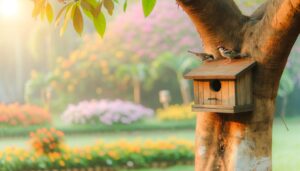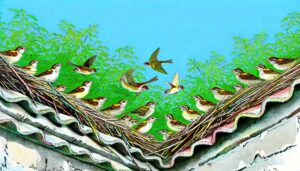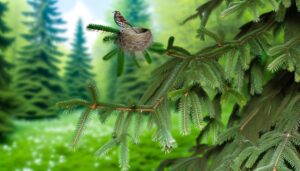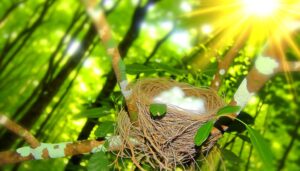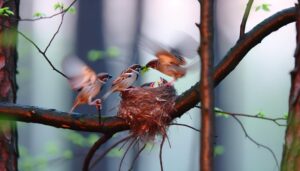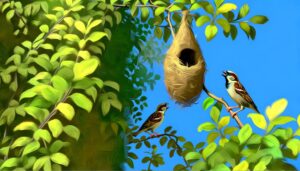Tips to Stop Sparrows Nesting in Bluebird Boxes
To stop sparrows from nesting in bluebird boxes, install boxes with entry holes limited to 1.5 inches to deter sparrows. Regularly inspect and remove any sparrow nests promptly.
Attach Sparrow Spookers after bluebirds lay their first egg to reduce sparrow aggression. Position bluebird boxes in open areas, away from buildings, and avoid placing them in clusters.
Use predator guards to protect against invaders. Employ sparrow-proof feeders to minimize competition for resources.
By understanding sparrow behavior and maintaining your bluebird boxes consistently, you'll enhance bluebird occupancy and deter invasive sparrows. Explore additional techniques to guarantee bluebird nesting success.
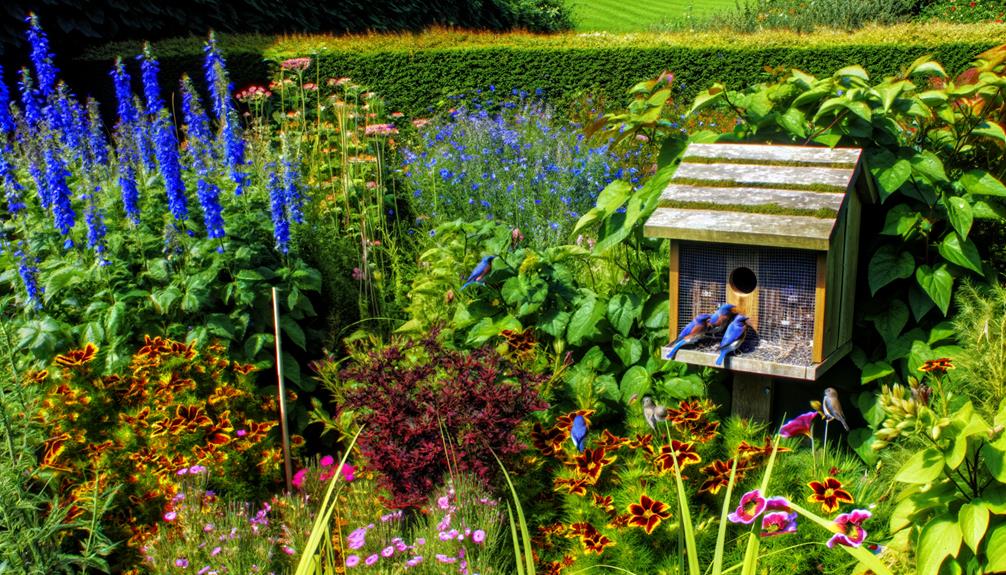
Key Takeaways
- Install bluebird boxes with entry holes restricted to 1.5 inches in diameter to prevent sparrows from entering.
- Regularly inspect and promptly remove any sparrow nests from bluebird boxes to discourage persistent nesting.
- Use Sparrow Spookers after bluebirds lay their first egg to deter sparrows through shiny, reflective materials.
- Ensure bluebird boxes have proper ventilation, drainage holes, and insulation to attract bluebirds and deter sparrows.
- Position bluebird boxes in open areas at the correct height, away from dense vegetation preferred by sparrows.
Understand Sparrow Behavior
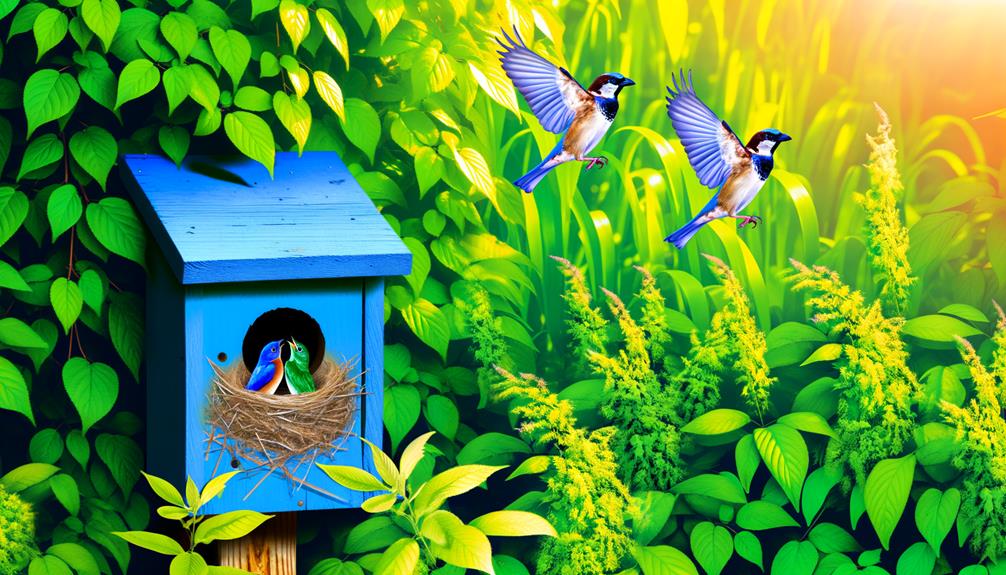
To effectively prevent sparrows from nesting in bluebird boxes, you need to understand their aggressive territorial behavior and nesting habits. Sparrows, particularly the House Sparrow, exhibit pronounced territorial aggression, often outcompeting native bluebirds for nesting sites.
They prefer nesting in cavities and readily occupy bluebird boxes. Their nests are bulky, constructed from coarse grasses, feathers, and debris, often filling the entire box. Sparrows are persistent and will quickly rebuild if their nests are removed.
Choose the Right Box
Selecting an appropriately designed bluebird box is crucial for deterring sparrows and promoting bluebird habitation. By choosing the right box, you enhance bluebird nesting while minimizing sparrow intrusion.
Research indicates that specific design features can optimize bluebird occupancy:
- Entrance Hole Size: Make sure the hole diameter is 1.5 inches; larger holes allow sparrows access.
- Interior Dimensions: Maintain a depth of 9-12 inches from entrance to floor to discourage sparrows.
- Material Selection: Opt for untreated wood, which provides insulation and mimics natural nesting sites.
- Ventilation and Drainage: Incorporate sufficient vents and drainage holes to regulate temperature and moisture levels.
Install Sparrow Spookers
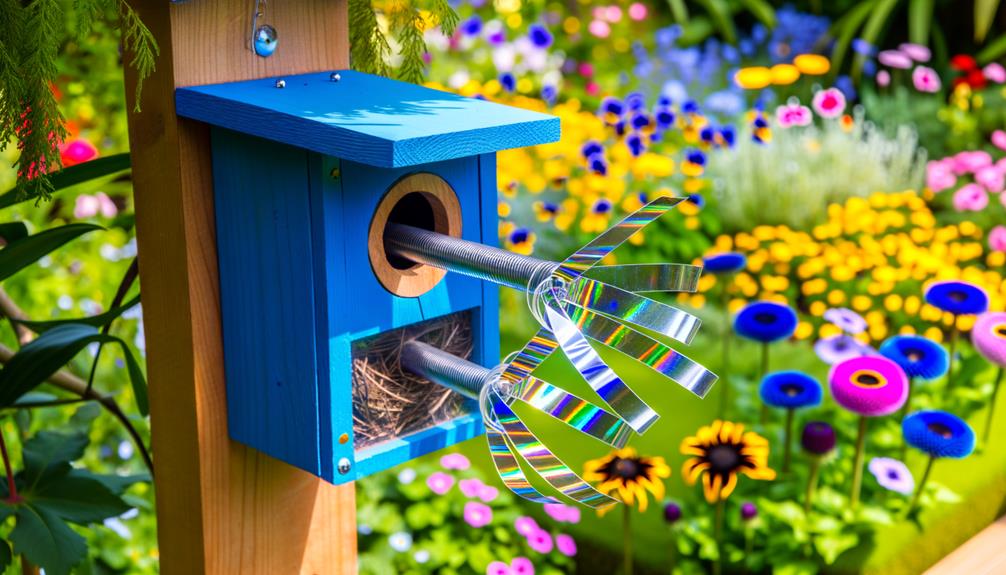
Utilizing sparrow spookers effectively can greatly reduce the chances of House Sparrows outcompeting bluebirds for nesting sites. Sparrow spookers are devices designed to deter sparrows by simulating predator presence or creating visual disturbances.
Install these spookers immediately after bluebirds lay their first egg. Attach shiny, reflective materials like Mylar strips to the top of the bluebird box. The movement and reflections from these strips make sparrows uncomfortable, discouraging them from approaching the nest box.
Research indicates that spookers are most effective when used in combination with other deterrent methods. Observational studies show a significant reduction in sparrow activity around boxes equipped with spookers.
Use Predator Guards
Complementing the use of sparrow spookers, installing predator guards on bluebird boxes can further enhance the protection of nesting bluebirds from both avian and terrestrial threats. Predator guards serve as physical barriers, deterring species such as raccoons, snakes, and even larger birds from accessing the nest. Research indicates that effective predator guards can greatly increase fledging success rates.
Consider implementing the following types of predator guards:
- Noel Guards: Metal mesh barriers that prevent predators from reaching the entrance hole.
- Baffle Guards: Cylindrical barriers placed around the pole supporting the nest box.
- Cone Guards: Conical structures that prevent climbing predators.
- Stovepipe Guards: Large, slippery tubes that deter climbing.
Each type offers unique benefits, ensuring a thorough approach to safeguarding bluebird nests.
Monitor and Remove Sparrow Nests
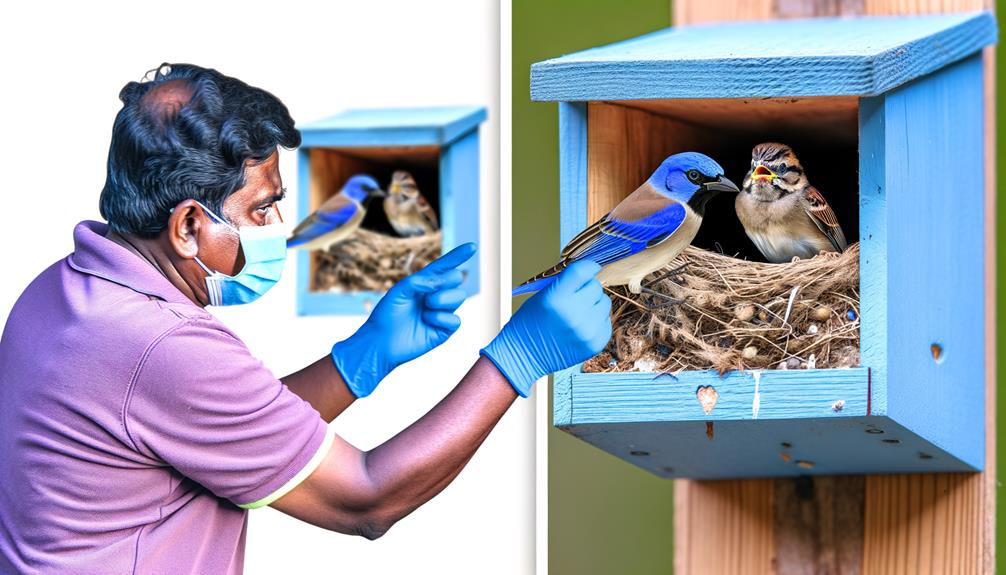
Regularly inspecting bluebird boxes for sparrow nests helps ensure the successful prevention of invasive species from overtaking the nesting sites. You need to check the boxes at least once a week during the breeding season. When you find a sparrow nest, remove it immediately. Sparrow nests typically consist of rough grasses, feathers, and litter. Differentiating between sparrow and bluebird nests is essential.
| Species | Nest Characteristics |
|---|---|
| Bluebird | Fine grasses, neat cup shape |
| Sparrow | Coarse grasses, messy structure |
| Bluebird | Clean with fewer materials |
| Sparrow | Includes feathers and litter |
| Bluebird | No feathers or trash |
Restrict Entry Holes
To guarantee that the entry holes of bluebird boxes are limited to 1.5 inches in diameter can prevent larger, invasive sparrows from entering and taking over the nesting sites. This precise measurement is critical as it exclusively accommodates bluebirds while deterring sparrows. Studies demonstrate that sparrows, with their broader body size, can't navigate through such a confined aperture.
To achieve this, consider the following methods:
- Install metal hole restrictors: These can be affixed to existing boxes to precisely control entry dimensions.
- Use pre-fabricated bluebird boxes: These come with built-in, correctly sized entry holes.
- Conduct regular inspections: Ensure no enlargement of holes by other species.
- Replace damaged boxes: Promptly address any wear that alters the entry size.
Control Nearby Food Sources

To prevent sparrows from nesting in bluebird boxes, you should control nearby food sources by limiting seed availability and removing food waste.
Research shows that sparrows are attracted to easy food sources, so using bird feeders strategically can minimize their presence.
Limit Seed Availability
Limiting the availability of seeds in your yard can greatly reduce the attractiveness of bluebird boxes to sparrows, as they're less likely to nest in areas with scarce food sources.
By strategically managing seed sources, you can create a less hospitable environment for sparrow habitation. Research indicates that sparrows prefer nesting near abundant food supplies. Therefore, consider these measures:
- Remove bird feeders that cater to sparrows, replacing them with feeders designed for bluebirds.
- Eliminate ground seed spillage, which can attract sparrows and other unwanted species.
- Plant native flora that doesn't produce seeds palatable to sparrows.
- Use seed catchers under feeders to minimize spill and waste.
Implementing these steps can significantly deter sparrows from nesting in your bluebird boxes.
Remove Food Waste
When you regularly clean up food waste around your yard, sparrows are less likely to be attracted to the area, thereby reducing their interest in nesting in bluebird boxes. Sparrows are opportunistic feeders and are drawn to leftover food scraps and spilled birdseed. By eliminating these food sources, you disrupt their foraging patterns.
Conduct detailed inspections of your yard and promptly remove any food remnants. Research indicates that even small amounts of organic waste can sustain sparrow populations. Utilize sealed compost bins and make sure pet food is stored indoors.
Use Bird Feeders Strategically
Strategically placing bird feeders away from bluebird boxes can effectively control food sources that attract sparrows. By doing so, you reduce the likelihood of sparrows encroaching on bluebird nesting areas.
Research indicates that sparrows are opportunistic feeders, flocking to easily accessible food.
To optimize this strategy, consider the following:
- Distance: Place feeders at least 50 feet from bluebird boxes.
- Type of Feed: Use nyjer or safflower seeds, which sparrows find less appealing.
- Feeder Design: Opt for feeders designed for specific species to minimize sparrow access.
- Feeding Schedule: Implement a timed feeding schedule to regulate food availability.
Place Boxes Strategically
When placing bluebird boxes, you should make sure there's adequate distance between each box to reduce territorial conflicts. Research indicates that bluebirds prefer open habitats with scattered trees, so avoid dense forests or urban areas.
Additionally, mount the boxes at a height of 4-6 feet to optimize bluebird occupancy and deter sparrows.
Distance Between Boxes
Placing bluebird boxes at least 100 yards apart greatly reduces the likelihood of sparrows colonizing them. This spacing strategy minimizes interspecies competition, as house sparrows are less likely to travel far distances to establish new territories.
By separating the boxes, you create a more favorable environment for bluebirds, allowing them to thrive without the constant threat of invasive sparrows.
Consider implementing these research-based recommendations:
- Monitor nesting activity: Regularly check the boxes to confirm bluebirds are the primary occupants.
- Install sparrow-resistant entry holes: Use slot boxes or smaller entrance holes to deter sparrows.
- Maintain vegetation: Keep the area around the boxes clear of dense shrubbery that sparrows prefer.
- Employ sparrow traps: Use humane traps to capture and relocate persistent sparrows.
Habitat Preferences
Properly positioning bluebird boxes in open, grassy areas with sparse tree coverage helps cater to the habitat preferences of bluebirds and deters sparrows from settling. Bluebirds prefer open spaces for feeding and minimal forested areas, which sparrows find less attractive. Research shows that bluebirds thrive in habitats with specific features, reducing competition from sparrows.
| Habitat Feature | Bluebirds Prefer |
|---|---|
| Open grassy areas | Yes |
| Sparse tree coverage | Yes |
| Dense forests | No |
| Urban environments | No |
Height Considerations
Strategically positioning bluebird boxes between five to ten feet above the ground significantly reduces the likelihood of sparrow occupation while aligning with bluebirds' natural nesting preferences. This height range is optimal based on extensive ornithological research and field observations.
Bluebirds prefer nesting at these elevations, which offer safety from many terrestrial predators and a commanding view of their territory.
Consider the following for effective bluebird box placement:
- Elevation Range: Maintain boxes 5-10 feet above the ground.
- Habitat Features: Secure open areas with minimal shrubbery to reduce cover for sparrows.
- Predator Guards: Install baffles or other deterrents to protect against climbing predators.
- Orientation: Face the box entrance away from prevailing winds to provide a stable environment.
Use Sparrow-Proof Feeders
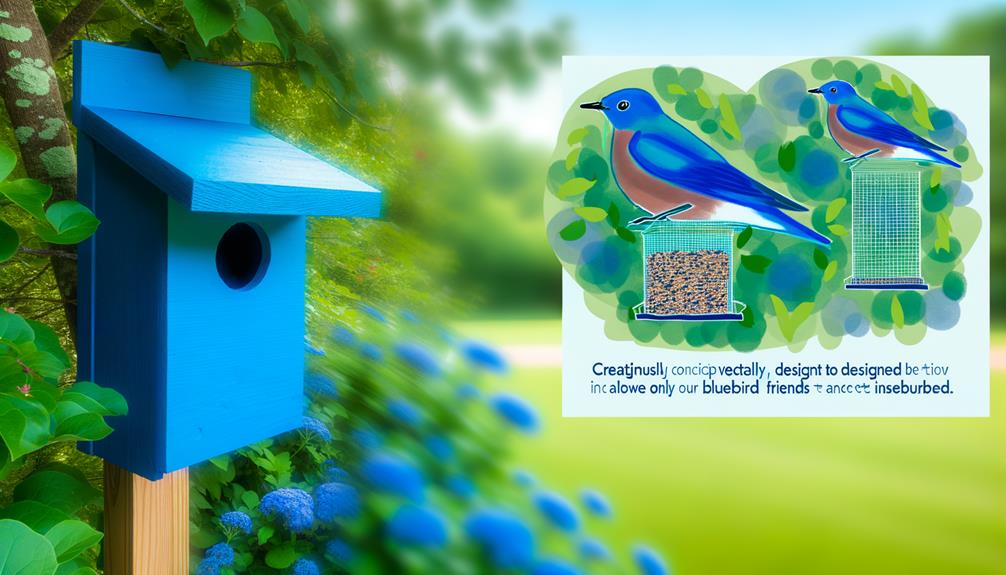
Implementing sparrow-proof feeders can greatly reduce competition and aggression from sparrows, thereby enhancing the nesting success of bluebirds. Opt for feeders designed with small entry points, as sparrows have bulkier bodies compared to bluebirds. Research indicates these feeders preferentially attract bluebirds while deterring sparrows. Additionally, position feeders away from bluebird boxes to minimize sparrow proximity to nesting sites.
Here's a quick comparison to help you choose:
| Feature | Sparrow-Proof Feeder | Regular Feeder |
|---|---|---|
| Entry Point Size | Small | Large |
| Attracts Sparrows | No | Yes |
| Attracts Bluebirds | Yes | Yes |
| Positioning | Away from boxes | Near boxes |
| Effectiveness | High | Low |
Regularly Inspect Boxes
You should regularly inspect bluebird boxes to prevent sparrows from taking control.
Periodically monitor the entry holes for signs of sparrow activity and promptly remove any sparrow nests you find.
Additionally, check for eggs to guarantee that bluebirds remain the primary inhabitants.
Monitor Entry Holes
Regularly examine the entry holes of bluebird boxes, as timely detection of nesting attempts by sparrows can significantly reduce their impact. Monitoring these entry points guarantees you can identify and address sparrow activity before it escalates.
Utilize high-precision calipers to measure the diameter, maintaining the ideal size of 1.5 inches to deter sparrows. Consistent observation is essential; note any changes in the entry hole's circumference or the presence of debris indicative of sparrow occupation.
- Check for signs of pecking or enlargement.
- Look for nesting materials, such as grass or feathers.
- Survey the immediate vicinity for sparrow activity.
- Record findings in a log for trend analysis.
Implementing these measures supports the bluebird population and aids in maintaining ecological balance.
Remove Sparrow Nests
After monitoring entry holes, it's crucial to regularly inspect bluebird boxes and promptly eliminate any sparrow nests to prevent further occupation. Research indicates that house sparrows (Passer domesticus) aggressively compete with native bluebirds for nesting sites. By removing their nests, you disrupt their breeding cycle and discourage return.
| Step | Action | Frequency |
|---|---|---|
| 1 | Inspect boxes | Weekly |
| 2 | Identify sparrow nests | Immediately |
| 3 | Remove nests | Immediately |
Scientific observations reveal that sparrow nests are typically constructed from coarse grass, feathers, and litter. Bluebird nests, conversely, are composed of fine grasses arranged neatly. Regular inspections guarantee that sparrows don't have a chance to establish dominance, thereby aiding bluebirds in thriving environments.
Check for Eggs
Inspecting bluebird boxes for eggs is essential to ensure that only desired bird species are using the nesting sites. Regular inspections allow you to identify and remove any house sparrow eggs, thereby safeguarding bluebird populations.
Follow these steps during your inspections:
- Frequency: Check the boxes at least twice a week during the breeding season.
- Identification: Learn to differentiate between bluebird and sparrow eggs. Bluebird eggs are typically pale blue, while sparrow eggs are speckled.
- Removal: Safely eliminate any house sparrow eggs you find to prevent them from hatching.
- Record-Keeping: Document your findings to track nesting activities and nest box usage over time.
Conclusion
By understanding sparrow behavior and choosing the right bluebird box, you're already halfway to success.
Installing sparrow deterrents and predator guards provides extra protection.
Monitoring and removing sparrow nests, controlling nearby food sources, and placing boxes strategically are essential steps.
Are you using sparrow-resistant feeders and regularly inspecting your boxes?
Combining these research-based methods will secure your bluebird boxes remain safe havens.
Observations confirm these strategies work, so stay vigilant and proactive to protect your bluebirds.

